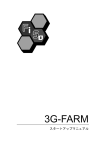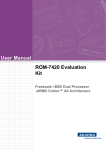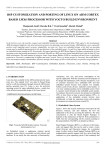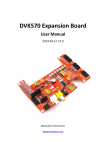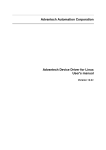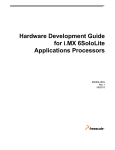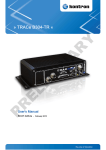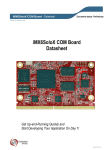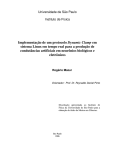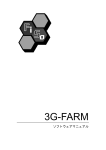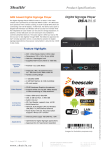Download 8106 type ME Data Sheet
Transcript
Murata Wi-Fi/BT EVK for i.MX6 Quick Start Guide (Linux) Revision History Revision Date Author Change Description 1.0 Sept 1, 2015 S Kerr, G Mohiuddin Initial Release 1.1 Sept 6, 2015 S Kerr Removed software compile/build dependency. User can bring up Freescale platform by downloading necessary files before flashing bootable SD card. Refer to Linux User Guide on software build procedures. 2.0 Nov 7, 2015 S Kerr Modified Murata Wi-Fi/BT EVK definition. This simplifies bring-up on Freescale i.MX6 Platforms. Incorporated changes for i.MX6UL 3.14.38 GA BSP Release. ©2009-2015 by Murata Electronics N.A., Inc. Murata Wi-Fi/BT EVK for i.MX6 Quick Start Guide (Linux) 2.0 11/07/15 www.murata.com This page intentionally left blank. ©2009-2015 by Murata Electronics N.A., Inc. Murata Wi-Fi/BT EVK for i.MX6 Quick Start Guide (Linux) 2.0 11/07/15 Page 2 of 27 www.murata.com Table of Contents REVISION HISTORY .............................................................................................................................................................. 1 TABLE OF CONTENTS ......................................................................................................................................................... 3 1 INTRODUCTION ............................................................................................................................................................ 5 1.1 Acronyms ................................................................................................................................................................... 8 1.2 References ................................................................................................................................................................. 8 1.2.1 Linux User Manual............................................................................................................................................. 8 1.2.2 Hardware User Manual ..................................................................................................................................... 8 2 CONNECTING TO I.MX 6SOLOX SABRE-SD ............................................................................................................. 9 2.1 2.2 3 CONNECTING TO I.MX 6SOLOLITE EVK ................................................................................................................. 11 3.1 4 Murata i.MX InterConnect V2 Adapter ..................................................................................................................... 15 PREPARING BOOTABLE SD CARD FOR I.MX6 WITH MURATA WI-FI/BT EVK ................................................... 16 6.1 6.2 6.3 6.4 6.5 7 Murata i.MX InterConnect V2 Adapter ..................................................................................................................... 13 Murata i.MX InterConnect V1 Adapter (Optional) .................................................................................................... 14 CONNECTING TO I.MX 6ULTRALITE EVK ............................................................................................................... 15 5.1 6 Murata i.MX InterConnect V1 Adapter ..................................................................................................................... 11 CONNECTING TO I.MX 6QUAD/DUALLITE SABRE-SD .......................................................................................... 12 4.1 4.2 5 Murata i.MX InterConnect V1 Adapter ....................................................................................................................... 9 Murata i.MX InterConnect V2 Adapter (Optional) .................................................................................................... 10 IMPORTANT: Getting Signed Up for Freescale and Broadcom Portals ................................................................. 16 Downloading Freescale and Broadcom Packages .................................................................................................. 16 Downloading i.MX6 Image Files to Flash SD Card .................................................................................................. 17 Flashing SD Card ..................................................................................................................................................... 17 Copying/Replacing/Modifying Files on SD Card ...................................................................................................... 17 TEST/VERIFICATION OF WI-FI AND BLUETOOTH .................................................................................................. 19 7.1 Bringing up Wi-Fi for Quick Test/Verification ........................................................................................................... 19 7.2 Bringing up Bluetooth for Quick Test/Verification .................................................................................................... 22 7.2.1 i.MX 6Quad/DualLite SABRE-SD (Default: V2 Adapter) ................................................................................. 23 7.2.2 i.MX 6SoloX SABRE-SD (Default: V1 Adapter) .............................................................................................. 23 7.2.3 i.MX 6SoloX SABRE-SD (Optional: V2 Adapter) ............................................................................................ 23 7.2.4 i.MX 6SoloLite EVK (Default: V1 Adapter) ...................................................................................................... 24 7.2.5 i.MX 6UltraLite EVK (Default: V2 Adapter) ...................................................................................................... 24 8 VERIFYING ADAPTER BOARDS ............................................................................................................................... 24 8.1 8.2 9 Murata i.MX InterConnect V1 Adapter ..................................................................................................................... 24 Murata i.MX InterConnect V2 Adapter ..................................................................................................................... 26 TECHNICAL SUPPORT CONTACT ............................................................................................................................ 27 ©2009-2015 by Murata Electronics N.A., Inc. Murata Wi-Fi/BT EVK for i.MX6 Quick Start Guide (Linux) 2.0 11/07/15 Page 3 of 27 www.murata.com LIST OF TABLES Table 1: Murata Wi-Fi/BT EVK (for i.MX6) Contents .............................................................................................................. 5 Table 2: Murata Wi-Fi/BT EVK’s Supported ........................................................................................................................... 6 Table 3: Murata i.MX InterConnect Adapter Selection Table ................................................................................................. 7 Table 4: Acronyms used in Quick Start Guide ........................................................................................................................ 8 Table 5: i.MX6 Bundle Download Links and Specific SD Card Image Filenames ................................................................ 17 Table 6: i.MX6 Targets supported on Linux 3.14.38 GA Release ........................................................................................ 18 Table 7: GPIO and UART Settings for Bluetooth Tests ........................................................................................................ 22 LIST OF FIGURES Figure 1: Murata IMX Interconnect Kit Interfaces ................................................................................................................... 6 Figure 2: i.MX 6SoloX SABRE-SD with V1 Adapter and Type ZP EVB ................................................................................. 9 Figure 3: i.MX 6SoloX SABRE-SD with V2 Adapter and Type 1DX EVB ............................................................................. 10 Figure 4: i.MX 6SoloLite EVK with V1 Adapter and Type 1DX EVB..................................................................................... 11 Figure 5: i.MX 6Quad SABRE-SD (Inverted) with V2 Adapter and Type ZP EVB ............................................................... 13 Figure 6: i.MX 6Quad SABRE-SD with V1 Adapter and Type 1DX EVB ............................................................................. 14 Figure 7: i.MX 6UltraLite EVK with V2 Adapter and Type 1DX EVB .................................................................................... 15 Figure 8: Murata i.MX InterConnect V1 Adapter - Top ......................................................................................................... 24 Figure 9: Murata i.MX InterConnect V1 Adapter – Bottom #1 .............................................................................................. 25 Figure 10: Murata i.MX InterConnect V1 Adapter – Bottom #2 ............................................................................................ 25 Figure 11: Murata i.MX InterConnect Adapter V2 Adapter - Top.......................................................................................... 26 Figure 12: Murata i.MX InterConnect Adapter V2 Adapter - Bottom .................................................................................... 27 ©2009-2015 by Murata Electronics N.A., Inc. Murata Wi-Fi/BT EVK for i.MX6 Quick Start Guide (Linux) 2.0 11/07/15 Page 4 of 27 www.murata.com 1 Introduction Murata has partnered with Freescale Semiconductor and Broadcom Corporation to offer a complete Wi-Fi and Bluetooth connectivity environment for building world class Internet-connected products. The Murata Connectivity Modules enable developers to minimize the development time and effort for connectivity function implementation. This guide provides details for getting started with Wi-Fi and Bluetooth on iMX6 platforms using Freescale Linux 3.14.38_6UL GA BSP. A typical Murata Wi-Fi/BT EVK contains all the hardware necessary to enable Wi-Fi and Bluetooth functionality: contents are listed in Table 1. Part #/ Picture of Contents Description of Contents Tag Color Murata Wi-Fi/BT EVB such as Type ZP, Type 1BW, Type 1DX and SN8000. Type ZP is pictured. See Table 2. 1. Murata i.MX InterConnect V1: SD pins (DAT0..7) provide both Wi-Fi SDIO and Bluetooth UART connection. Wired SD Card Extender connects control signals: 2. WL_REG_ON BT_REG_ON WL_HOST_WAKE (optional) Murata i.MX InterConnect V2: SD pins provide Wi-Fi SDIO; ribbon cable connection provides Bluetooth UART and control signals. 50 mm ribbon cable included. 3. 2.4/5.0 GHz Whip/Tilt SMA Antenna (for dual-band Wi-Fi) Or 4. 2.4 GHz Whip SMA Antenna (for single band Wi-Fi) Table 1: Murata Wi-Fi/BT EVK (for i.MX6) Contents ©2009-2015 by Murata Electronics N.A., Inc. Murata Wi-Fi/BT EVK for i.MX6 Quick Start Guide (Linux) 2.0 11/07/15 Page 5 of 27 www.murata.com Murata Wi-Fi/BT EVK’s supported on Freescale i.MX6 Platforms are listed in Table 2. Currently four modules are available. If you are having difficulty obtaining the desired Murata EVK, please contact Murata for additional support. Wi-Fi Bluetooth Smart Ready 802.11b/g/n/ac and BT EVK for i.MX6 LBEH5HMZPC-TEMP-DS-SD b/g/n/ac Yes Type 1BW EVK+ 802.11a/b/g/n and BT EVK for i.MX6 LBEH5DU1BW-TEMP-DS-SD a/b/g/n Yes Type 1DX EVK+ 802.11b/g/n and BT EVK for i.MX6 LBEE5KL1DX-TEMP-DS-SD b/g/n Yes SN8000 802.11b/g/n EVK for i.MX6 FCC certified, industrial 88-00153-90 b/g/n No Part Type ZP EVK+ Description Order part number Table 2: Murata Wi-Fi/BT EVK’s Supported Connection Diagram for the Murata Interconnect kit is provided in Figure 1. Murata Wi-Fi/BT kit for i.MX6 enables this configuration by providing two custom-built Adapter boards. Two adapter boards are provided in each kit to allowing the user to bring up the Wi-Fi/Bluetooth interfaces in the easiest manner possible. BLUETOOTH Freescale i.MX6 Platform HCI H4-UART CTRL Signals WL_REG_ON BT_REG_ON WL_HOST_WAKE Murata i.MX InterConnect WLAN SDIO Murata Wi-Fi/BT EVB: ZP/1BW/ 1DX/ SN8000 Figure 1: Murata IMX Interconnect Kit Interfaces Note: 3rd party Freescale i.MX6 EVK’s are *not* supported. ©2009-2015 by Murata Electronics N.A., Inc. Murata Wi-Fi/BT EVK for i.MX6 Quick Start Guide (Linux) 2.0 11/07/15 Page 6 of 27 www.murata.com Table 3 presents the Freescale Platform and Murata Wi-Fi/BT EVK configurations. The first column displays the default i.MX InterConnect Adapter (V1 or V2) for each combination of Freescale branded i.MX6 Reference Platforms and Murata Wi-Fi/BT EVK. An additional column indicates the optional configuration. NOTE: Murata recommends the default configuration. As Table 3 indicates, currently four (4) Freescale i.MX6 Platforms are supported. There is only one complication for default configuration. Namely the i.MX 6Quad/DualLite SABRE-SD requires rework to successfully interface with the Murata hardware. As shipped from the factory, the i.MX 6Quad/DualLite SABRE-SD does not connect the J13 Bluetooth ribbon cable connector to the necessary UART and control signals. Please reference the Hardware User Manual for necessary rework. If Wi-Fi only functionality is acceptable then V1 Adapter is well suited (see optional column). The only other optional hardware configuration is for i.MX 6SoloX SABRE-SD. The V1 adapter requires no rework for this platform and is the default configuration. However if the V2 adapter is desired (frees up one SD2 card slot) then rework is necessary. For specifics please reference the Hardware User Manual. Only one of the four i.MX6 Platforms do not connect all control signals: WL_REG_ON, BT_REG_ON, and WL_HOST_WAKE. The i.MX6 UltraLite EVK does not connect WL_HOST_WAKE by default. Freescale i.MX6 Platform i.MX6Quad/DualLite SABRE-SD i.MX 6SoloX SABRE-SD DEFAULT OPTIONAL V2 V1 (Rework Required) (Wi-Fi Only) V1 V2 (Rework Required) i.MX 6SoloLite EVK V1 N/A i.MX 6UltraLite EVK V2 N/A Notes Please reference section 3.3.2.1 of Hardware User Manual for rework instructions. V1 adapter option requires different DTB file. For V2 adapter option, please reference section 3.1.2.1 of Hardware User Manual for rework instructions. V2 adapter requires different DTB file. Rework necessary to UltraLite platform is option WL_HOST_WAKE is required. Please reference section 3.4.1.1 of Hardware User Manual for rework instructions. Table 3: Murata i.MX InterConnect Adapter Selection Table For any given Freescale Platform/Murata EVK, click on the corresponding “V1” or “V2” hyperlink to get redirected to relevant section in document. ©2009-2015 by Murata Electronics N.A., Inc. Murata Wi-Fi/BT EVK for i.MX6 Quick Start Guide (Linux) 2.0 11/07/15 Page 7 of 27 www.murata.com 1.1 Acronyms Acronym API DTB EVB EVK FW GPIO PC SW UART USB Meaning Application Programming Interface Device Tree Blob: Kernel reads in at boot time for configuration. Evaluation Board (Murata module on custom PCB) Evaluation Kit (includes EVB + Adapter) Firmware General Purpose Input/Output Personal Computer Software Universal Asynchronous Receiver/Transmitter Universal Serial Bus Table 4: Acronyms used in Quick Start Guide 1.2 References 1.2.1 Linux User Manual Murata Wi-Fi/BT EVK for i.MX6 Linux User Manual 2.0, “Murata Wi-Fi BT EVK for i.MX6 Linux User Manual 2.0.pdf”. This manual describes all steps necessary to build the file system, kernel, DTB files, and WLAN “bcmdhd” driver necessary for supporting Freescale i.MX6 Platforms and the Murata Wi-Fi/BT EVK. 1.2.2 Hardware User Manual Murata Wi-Fi/BT EVK for i.MX6 Hardware User Manual 2.0, “Murata Wi-Fi BT EVK for i.MX6 Hardware User Manual 2.0.pdf”. This manual details the Murata Wi-Fi/BT EVK InterConnect Adapter hardware. All interface signals to the Freescale i.MX6 Platforms are described. Specifics on interfacing each i.MX6 Platform to Murata Wi-Fi/BT EVK are provided. ©2009-2015 by Murata Electronics N.A., Inc. Murata Wi-Fi/BT EVK for i.MX6 Quick Start Guide (Linux) 2.0 11/07/15 Page 8 of 27 www.murata.com 2 Connecting to i.MX 6SoloX SABRE-SD Referring to Table 3, the V1 Adapter is the default solution for this platform. No rework is required, Murata Wi-Fi/BT EVB is oriented right-side up, and it provides both Wi-Fi and BT functionality via SD3/SD2 slots: see Figure 2 below. 2.1 Murata i.MX InterConnect V1 Adapter [1] Make sure no power is applied to i.MX 6SoloX SABRE-SD. [2] Check that VIO setting on Murata i.MX6 Interconnect V1 Adapter (Part #2 in Table 1) is set to 3.3V (VBAT_SDIO). Refer to Red Rectangle for correct jumper setting in Figure 8. [3] Insert V1 Adapter board into SD3 slot and SD Card Extender into SD2 slot. Note the orientation as shown in Figure 2. [4] Connect antenna (Part #4) to the SMA connector of the Murata EVB (Part #1). [5] Now you can connect the EVB to the 60-pin Samtec connector on the V1 Adapter board. [6] Prepare SD card to boot platform per Section 6. U-boot has to be specific for i.MX 6SoloX. [7] Power on platform and interrupt at u-boot. Type in following commands to set correct DTB file: => setenv fdt_file imx6sx-sdb-murata-v1_sdext.dtb => saveenv => reset (causes platform to boot kernel) [8] Refer to Section 7 to test/verify Wi-Fi and Bluetooth functionality. Figure 2: i.MX 6SoloX SABRE-SD with V1 Adapter and Type ZP EVB ©2009-2015 by Murata Electronics N.A., Inc. Murata Wi-Fi/BT EVK for i.MX6 Quick Start Guide (Linux) 2.0 11/07/15 Page 9 of 27 www.murata.com 2.2 Murata i.MX InterConnect V2 Adapter (Optional) Refer to the Hardware User Manual for detailed necessary rework instructions on i.MX 6SoloX SABRE-SD. Both WL_REG_ON and WL_HOST_WAKE need to be connected. Clearly two advantages with this configuration: “tidy” solution and opens up SD3 slot: see Figure 3 below. These steps will only pass if Freescale Platform has been correctly reworked. [1] Make sure no power is applied to i.MX 6SoloX SABRE-SD. [2] Check that VIO setting on Murata i.MX6 Interconnect V2 Adapter (Part #3 in Table 1) is set to 3.3V (VBAT_SDIO). Refer to Red Rectangle for correct jumper setting in Figure 11. [3] After connecting ribbon cable to both adapter and i.MX 6SoloX, insert V2 Adapter board into SD2 slot. Refer to the Hardware User Manual for more information on ribbon cable connection. [4] Connect antenna (Part #4) to the SMA connector of the Murata EVB (Part #1). [5] Now you can connect the EVB to the 60-pin Samtec connector on the V2 Adapter board. [6] Prepare SD card to boot platform per Section 6. U-boot has to be specific for i.MX 6SoloX. [7] Power on platform and interrupt at u-boot. Type in following commands to set correct DTB file: => setenv fdt_file imx6sx-sdb-murata-v2.dtb => saveenv => reset (causes platform to boot kernel) [8] Refer to Section 7 to test/verify Wi-Fi and Bluetooth functionality. Figure 3: i.MX 6SoloX SABRE-SD with V2 Adapter and Type 1DX EVB ©2009-2015 by Murata Electronics N.A., Inc. Murata Wi-Fi/BT EVK for i.MX6 Quick Start Guide (Linux) 2.0 11/07/15 Page 10 of 27 www.murata.com 3 Connecting to i.MX 6SoloLite EVK Referring to Table 3, V1 Adapter is the only solution for this platform. Murata Wi-Fi/BT EVB is oriented right-side up, and it provides both Wi-Fi and BT functionality via SD1 slot with control signals connected from SD3 slot using SD Card Extender: see Figure 4 below. 3.1 Murata i.MX InterConnect V1 Adapter [1] Make sure no power is applied to i.MX 6SoloLite EVK. [2] Check that VIO setting on Murata i.MX6 Interconnect V1 Adapter (Part #2 in Table 1) is set to 3.3V (VBAT_SDIO). Refer to Red Rectangle for correct jumper setting in Figure 8. [3] Insert V1 Adapter board into SD1 slot and SD Card Extender into SD3 slot. Note the orientation as shown in Figure 4. [4] Connect antenna (Part #4) to the SMA connector of the Murata EVB (Part #1). [5] Now you can connect the EVB to the 60-pin Samtec connector on the V1 Adapter board. [6] Prepare SD card to boot platform per Section 6. U-boot has to be specific for i.MX 6SoloLite. [7] Power on platform and interrupt at u-boot. Type in following commands to set correct DTB file: => setenv fdt_file imx6sl-evk-murata-v1_sdext.dtb => saveenv => reset (causes platform to boot kernel) [8] Refer to Section 7 to test/verify Wi-Fi and Bluetooth functionality. Figure 4: i.MX 6SoloLite EVK with V1 Adapter and Type 1DX EVB ©2009-2015 by Murata Electronics N.A., Inc. Murata Wi-Fi/BT EVK for i.MX6 Quick Start Guide (Linux) 2.0 11/07/15 Page 11 of 27 www.murata.com 4 Connecting to i.MX 6Quad/DualLite SABRE-SD Referring to Table 3, the i.MX 6Quad/DualLite SABRE-SD presents additional challenges. If the only interface required is WLAN, then the V1 Adapter on SD2 slot (with SD Card Extender on SD3 slot) provides an adequate solution. However if Bluetooth (UART) connection is required, then the only option is to rework the Freescale platform. As shipped from the factory, the i.MX 6Quad/DualLite SABRE-SD does not connect the J13 Bluetooth ribbon cable connector to the necessary UART and control signals. Please reference the Hardware User Manual for necessary rework. Freescale also details the board rework in their schematic file (Bluetooth page). Page 15 of the Freescale schematic (SPF-27516_C3.pdf) correctly captures the necessary rework to be done. Repeated here: NOTE: To use J13, populate resistors R209 - R213 and depopulated the SPI NOR FLASH U14. Resistors R214 and R215 should not be populated because both UART outputs (TXDs) have been crossed together and both UART inputs (RXDs) have been crossed together. To make the UART work correctly, solder a jumper wire from R215 pad 1 to R214 pad 2 and from R215 pad 2 to R214 pad 1. If (after rework) V2 Adapter does not look to work correctly, try V1 Adapter and verify just Wi-Fi functionality. Board rework can only be done by a skilled technician with the correct tools. ©2009-2015 by Murata Electronics N.A., Inc. Murata Wi-Fi/BT EVK for i.MX6 Quick Start Guide (Linux) 2.0 11/07/15 Page 12 of 27 www.murata.com 4.1 Murata i.MX InterConnect V2 Adapter These steps will only pass if Freescale Platform has been correctly reworked. See Section 4. NOTE: The Freescale i.MX6 platform has been inverted. This makes working with Wi-Fi/BT EVK much easier. The one drawback is if Ethernet port must be accessed. To properly match Wi-Fi/BT EVK and i.MX6 platform heights, nylon washers are added as additional spacers to “standard” Freescale i.MX6 standoffs. [1] Make sure no power is applied to i.MX 6Quad/DualLite SABRE-SD. [2] Check that VIO setting on Murata i.MX6 Interconnect V2 Adapter (Part #3 in Table 1) is set to 3.3V (VBAT_SDIO). Refer to Red Rectangle for correct jumper setting in Figure 11. [3] After connecting ribbon cable to both adapter and i.MX6Q/DL, insert Adapter board into SD2 slot. Note the orientation as shown in Figure 5. [4] Connect antenna (Part #4) to the SMA connector of the Murata EVB (Part #1). [5] Now you can connect the EVB to the 60-pin Samtec connector on the Adapter board. [6] Prepare SD card to boot platform per Section 6. U-boot has to be specific for i.MX 6Quad/DL. [7] Power on platform and interrupt at u-boot. Type in following commands to set correct DTB file: => setenv fdt_file imx6q-sabresd-murata-v2.dtb (or imx6dl-sabresd-murata-v2.dtb) => saveenv => reset (causes platform to boot kernel) [9] Refer to Section 7 to test/verify Wi-Fi and Bluetooth functionality. Figure 5: i.MX 6Quad SABRE-SD (Inverted) with V2 Adapter and Type ZP EVB ©2009-2015 by Murata Electronics N.A., Inc. Murata Wi-Fi/BT EVK for i.MX6 Quick Start Guide (Linux) 2.0 11/07/15 Page 13 of 27 www.murata.com 4.2 Murata i.MX InterConnect V1 Adapter (Optional) This configuration only supports Wi-Fi functionality. NOTE: This Wi-Fi/BT configuration does not allow the user to use SD3 slot to default SD Card boot slot. To boot platform, the user must configure alternative boot method such as EMMC flash. [1] Make sure no power is applied to i.MX 6Quad/DualLite SABRE-SD. [2] Check that VIO setting on Murata i.MX6 Interconnect V1 Adapter (Part #2 in Table 1) is set to 3.3V (VBAT_SDIO). Refer to Red Rectangle for correct jumper setting in Figure 8. [3] Insert V1 Adapter board into SD2 slot and SD Card Extender into SD3 slot. Note the orientation as shown in Figure 6. [4] Connect antenna (Part #4) to the SMA connector of the Murata EVB (Part #1). [5] Now you can connect the EVB to the 60-pin Samtec connector on the Adapter board. [6] Prepare SD card to boot platform per Section 6. U-boot has to be specific for i.MX 6Quad/DL. [7] Power on platform and interrupt at u-boot. Type in following commands to set correct DTB file: => setenv fdt_file imx6q-sabresd-murata-v1_sdext.dtb (or imx6dl-sabresd-murata-v1_sdext.dtb) => saveenv => reset (causes platform to boot kernel) [8] Refer to Section 7 to test/verify Wi-Fi and Bluetooth functionality. Figure 6: i.MX 6Quad SABRE-SD with V1 Adapter and Type 1DX EVB ©2009-2015 by Murata Electronics N.A., Inc. Murata Wi-Fi/BT EVK for i.MX6 Quick Start Guide (Linux) 2.0 11/07/15 Page 14 of 27 www.murata.com 5 Connecting to i.MX 6UltraLite EVK Referring to Table 3, V2 adapter is the only solution for i.MX 6UltraLite EVK. No rework is required for V2 Adapter for providing both Wi-Fi (SDIO in-band interrupt signaling) and Bluetooth connectivity. NOTE: The default hardware configuration on i.MX 6UltraLite EVK only supports SDIO in-band interrupts. For out-of-band interrupts (WL_HOST_WAKE connected), rework is necessary. For specifics please reference the Hardware User Manual. 5.1 Murata i.MX InterConnect V2 Adapter [1] Make sure no power is applied to i.MX 6UltraLite EVK. [2] Check that VIO setting on Murata i.MX6 Interconnect V2 Adapter (Part #3 in Table 1) is set to 3.3V (VBAT_SDIO). Refer to Red Rectangle for correct jumper setting in Figure 11. [3] Connect antenna (Part #4) to the SMA connector of the Murata EVB (Part #1). [4] Connect the EVB to the 60-pin Samtec connector on the Adapter board. [5] Connect ribbon cable at both ends before inserting Murata EVK into SD1 slot. Note the orientation as shown in Figure 7. The UltraLite uses a “push-push” SD card connector. Make sure that the adapter clicks in correctly. [6] Prepare SD card to boot platform per Section 6. U-boot has to be specific for i.MX 6UltraLite. [7] Power on platform and interrupt at u-boot. Type in following commands to set correct DTB file: => setenv fdt_file imx6ul-14x14-evk-murata-v2.dtb => saveenv => reset (causes platform to boot kernel) [8] Refer to Section 7 to test/verify Wi-Fi and Bluetooth functionality. Figure 7: i.MX 6UltraLite EVK with V2 Adapter and Type 1DX EVB ©2009-2015 by Murata Electronics N.A., Inc. Murata Wi-Fi/BT EVK for i.MX6 Quick Start Guide (Linux) 2.0 11/07/15 Page 15 of 27 www.murata.com 6 Preparing Bootable SD Card for i.MX6 with Murata Wi-Fi/BT EVK The current release supported is Freescale Linux 3.14.38_6UL GA BSP. The L3.14.38_6UL release integrates the necessary Broadcom Wi-Fi and Bluetooth drivers. For this specific release, Freescale only provides a pre-built image for the i.MX 6UltraLite EVK. For other Freescale i.MX6 Platforms the end user must build the image using the Yocto distribution for L3.14.38. If you prefer to use L3.14.38 rootfs (ideal approach) then please reference the Linux User Manual. However to ease initial platform bring-up, a hybrid approach is taken (for non-UltraLite platforms) by using previous L3.14.28_GA rootfs with the new L3.14.38 Kernel, DTB, and Wi-Fi driver files: Download the appropriate i.MX6 “bundle”: hyperlinks provided in Table 5. Flash SD card with “*.sdcard” image file. Download modified kernel file (zImage), new Murata Device Tree Blob (DTB) files, and Wi-Fi driver (bcmdhd.ko) from Murata/i.MX Portal on Freescale Community website. For non-UltraLite platforms, copy zImage and dtb files to “/boot” folder. Also copy “bcmdhd.ko” to “/lib/modules/3.14.xx.yy/kernel/drivers/net/wireless/bcmdhd/” folder. For i.MX 6UltraLite, copy only necessary dtb file to “/boot” folder. Download Broadcom Firmware package from Freescale/Murata i.MX Support Portal on Broadcom Community website and copy to “/home/root” folder “Blacklist” the bcmdhd driver so there is no attempt to insmod it during kernel boot. This is accomplished by editing the “/etc/modprobe.d/blacklist.conf” file. 6.1 IMPORTANT: Getting Signed Up for Freescale and Broadcom Portals This is the only step which is time-sensitive. You need to be a registered user at both Freescale and Broadcom Community websites. Once you are registered please email [email protected] to gain access to both Freescale/Murata i.MX Support Portal and Murata/i.MX Portal. Turnaround for this request is typically no more than 24 hours. 6.2 Downloading Freescale and Broadcom Packages Once you have access, download the following packages: - L3.14.38_6ul-ga_binaries_11072015 - BRCM_FW_for_i.MX_11072015 ©2009-2015 by Murata Electronics N.A., Inc. Murata Wi-Fi/BT EVK for i.MX6 Quick Start Guide (Linux) 2.0 11/07/15 Page 16 of 27 www.murata.com 6.3 Downloading i.MX6 Image Files to Flash SD Card Table 5 provides direct download links to i.MX6 “Bundles” for each Freescale Platform. The available SD card images are included too. All links point to common www.freescale.com download area. Simply click on the hyperlink for the desired “SD Card Image File” and download the package. Once the download has finished pull the appropriate *.sdcard file from the bundle/package. i.MX6 Platform i.MX 6Quad/DualLite SABRE-SD Available SD Card Image Files fsl-image-gui-x11-imx6qdlsolo.sdcard fsl-image-qt5-x11-imx6qdlsolo.sdcard fsl-image-gui-x11-imx6sxsabresd.sdcard fsl-image-qt5-x11-imx6sxsabresd.sdcard fsl-image-gui-x11-imx6slevk.sdcard fsl-image-qt5-x11-imx6slevk.sdcard fsl-image-gui-x11-imx6ulevk.sdcard i.MX 6SoloX SABRE-SD i.MX 6SoloLite EVK i.MX 6UltraLite EVK Table 5: i.MX6 Bundle Download Links and Specific SD Card Image Filenames 6.4 Flashing SD Card Insert SD card into host machine (PC). The SD card must get enumerated as “/dev/sdx” device (may require SD card to USB adapter). Once SD card has been inserted, run “dmesg” command to find which “/dev/sdx” device just enumerated. NOTE: Before running next command, make sure you have selected correct device. Otherwise you can wipe your hard drive! $ sudo dd if=<fsl image name>.sdcard of=/dev/sdx bs=1M && sync 6.5 Copying/Replacing/Modifying Files on SD Card You will have already downloaded two packages from Section 6.2. Now we have to copy these files over to newly prepared SD card. First let’s take care of Freescale binary download (contains zImage, new dtb files, and bcmdhd.ko driver file). $ tar –xvf L3.14.38_6ul-ga_binaries_11072015.tar $ cd L3.14.38_6ul-ga_binaries_11072015 For non-UltraLite platforms, we copy over the modified kernel: $ sudo cp zImage <i.MX6 Target Boot folder> For all platforms, we need to copy over the modified DTB files: $ sudo cp *.dtb <i.MX6 Target Boot folder> ©2009-2015 by Murata Electronics N.A., Inc. Murata Wi-Fi/BT EVK for i.MX6 Quick Start Guide (Linux) 2.0 11/07/15 Page 17 of 27 www.murata.com Next two steps are optional. If already using L3.14.38 rootfs, then we don’t have to copy “bcmdhd.ko”. For previous L3.14.28 rootfs, perform next two steps: $ sudo mkdir <i.MX6 rootfs>/lib/modules/3.14.xx.yy/kernel/drivers/net/wireless/bcmdhd $ sudo cp bcmdhd.ko <i.MX6 rootfs>/lib/modules/3.14.xx.yy/kernel/drivers/net/wireless/bcmdhd/ To better understand the new Device Tree Blob (dtb) files, please refer to Table 6. The target i.MX6 device is listed along with options of dts/dtb files. DTS files are located at “/arch/arm/boot/dts”. DTB files are very useful when it comes to re-configuring hardware. When booting the platform, customer merely has to select the correct DTB file by using “setenv fdt_file” command at u-boot prompt. Target (MACHINE) imx6dlsabresd imx6qsabresd imx6slevk imx6sxsabresd imx6ulevk Default imx6dl-sabresd-murata-v2.dtb imx6q-sabresd-murata-v2.dtb imx6sl-evk-murata-v1_sdext.dtb imx6sx-sdb-murata-v1_sdext.dtb imx6ul-14x14-evk-murata-v2.dtb Optional imx6dl-sabresd-murata-v1_sdext.dtb imx6q-sabresd-murata-v1_sdext.dtb N/A imx6sx-sdb-murata-v2.dtb N/A Table 6: i.MX6 Targets supported on Linux 3.14.38 GA Release Next let’s take care of the Broadcom firmware drop. This step is just a simple copy. $ sudo cp BRCM_FW_for_i.MX_11072015.tar <i.MX6 rootfs>/home/root/ To prevent Broadcom WLAN (bcmdhd) driver being loaded during kernel boot, it must be added to “blacklist” configuration file. In the command below, “gedit” is used to edit the “blacklist.conf” file: $ sudo gedit <i.MX6 rootfs>/etc/modprobe.d/blacklist.conf add line: “blacklist bcmdhd”; save file Now the SD card is ready. Make sure all changes are saved correctly (i.e. “sync” command or “safely remove drive”, etc.) and plug it into the Freescale i.MX6 Platform. ©2009-2015 by Murata Electronics N.A., Inc. Murata Wi-Fi/BT EVK for i.MX6 Quick Start Guide (Linux) 2.0 11/07/15 Page 18 of 27 www.murata.com 7 Test/Verification of Wi-Fi and Bluetooth Now the kernel should be booting correctly on the platform with Murata Wi-Fi/BT EVK pugged in (i.e. already set correct DTB file when interrupting u-boot). Next steps are to quickly verify that Wi-Fi and Bluetooth are functional. Before testing either Wi-Fi or Bluetooth, there is one necessary step (first boot only on “fresh” SD card) to install the necessary firmware, NVRAM, and tool files. Once kernel has booted, you should see the Broadcom firmware package in the root home folder. First extract it (using “tar” command) and then run Murata shell script to install necessary files. Login: root $ ls BRCM_FW_for_i.MX_11072015.tar $ tar -xvf BRCM_FW_for_i.MX_11072015.tar $ cd BRCM_FW_for_i.MX_11072015 $ . ./Murata_Startup_Script.sh Expected output is (need to enter current Murata module being tested and hit return): Please enter EVB String (ZP, 1BW, 1DX, or SN8000): 1DX Selecting Murata Type 1DX... The Murata script file does the following: 1) Copies Bluetooth firmware “patch files” to “/etc/firmware” folder. 2) Copies Wi-Fi folders (ZP/1BW/1DX/SN8000) to “/lib/firmware/bcm” folder. Each of these folders contains firmware and NVRAM specific to each module. 3) Copies “WL” tool to “/bin” folder. This is a Broadcom-specific WLAN configuration/test utility. 4) Copies firmware and NVRAM for selected module to “/lib/firmware/bcm” folder. This script file defaults to copying over NVRAM for SDIO in-band interrupt signaling. 5) If user enters wrong module string then the script will exit with a warning statement. 7.1 Bringing up Wi-Fi for Quick Test/Verification To bring up Wi-Fi, a script file is included to make things easier. Invoke as follows: $ . ./insmod_Wi-Fi-Driver.sh Some of the key parameters: - “firmware_path” provides entire path and filename to firmware being loaded. - “nvram_path” provides entire path and filename to NVRAM being loaded. - “dhd_msg_level” sets debug output. Defaults to 0x1 (error only). For full logs, set this to 0xffff. NOTE: “insmod_Wi-Fi-Driver.sh” script may require editing so that correct path is used for “bcmdhd.ko” file. Path for 3.14.38 kernel is default. Path for 3.14.28 is commented out. ©2009-2015 by Murata Electronics N.A., Inc. Murata Wi-Fi/BT EVK for i.MX6 Quick Start Guide (Linux) 2.0 11/07/15 Page 19 of 27 www.murata.com Expected Output Is: dhd_module_init in Power-up adapter 'DHD generic adapter' wifi_platform_bus_enumerate device present 1 F1 signature OK, socitype:0x1 chip:0xa9a6 rev:0x1 pkg:0x3 DHD: dongle ram size is set to 524288(orig 524288) at 0x0 wifi_platform_get_mac_addr CFG80211-ERROR) wl_setup_wiphy : Registering Vendor80211) wl_create_event_handler(): thread:wl_event_handler:3a8 started CFG80211-ERROR) wl_event_handler : tsk Enter, tsk = 0xa9dc141c dhd_attach(): thread:dhd_watchdog_thread:3a9 started dhd_attach(): thread:dhd_dpc:3aa started dhd_deferred_work_init: work queue initialized dhdsdio_write_vars: Download, Upload and compare of NVRAM succeeded. dhd_bus_init: enable 0x06, ready 0x06 (waited 0us) wifi_platform_get_mac_addr Firmware up: op_mode=0x0005, MAC=fc:db:b3:80:eb:81 Firmware version = wl0: Dec 11 2014 04:20:45 version 7.10.323.34 (r520360) FWID 01-ea2beeba dhd_wlfc_init(): successfully enabled bdcv2 tlv signaling, 79 dhd_wlfc_init: query wlfc_mode succeed, fw_caps=0x1c dhd_wlfc_init(): wlfc_mode=0x1c, ret=0 Dongle Host Driver, version 1.141.72 (r) Compiled from Register interface [wlan0] MAC: fc:db:b3:80:eb:81 You can ignore the “CFG80211-ERROR” messages. Key line is the last one indicating that “wlan0” interface is active. Now invoke “ifconfig” command to bring up “wlan0”. “WL” can be invoked to actively scan the environment. The “scanresults” will return any visible SSID’s. $ ifconfig wlan0 192.168.1.111 up /* Other IP Address (or none) can be selected here. */ $ wl scan $ sleep 2 /* Delay inserted for Wi-Fi to obtain probe responses; increases for dual-band. */ $ wl scanresults NOTE: "CFG80211-ERROR) wl_notify_scan_status : scan is not ready" message is to be expected. The delay in command sequence is necessary. Otherwise “wl scanresults” returns nothing. Only once “CFG80211ERROR” message is logged to console, can “wl scanresults” be invoked. ©2009-2015 by Murata Electronics N.A., Inc. Murata Wi-Fi/BT EVK for i.MX6 Quick Start Guide (Linux) 2.0 11/07/15 Page 20 of 27 www.murata.com Expected Output Is: $ ifconfig wlan0 192.168.1.111 up $ wl scan “CFG80211-ERROR) wl_notify_scan_status : scan is not ready $ wl scanresults SSID: "Murata-WS-416F82" Mode: Managed RSSI: -68 dBm SNR: 0 dB noise: 0 dBm Flags: RSSI on-channel Channel: 1 BSSID: 00:0B:6C:41:6F:82 Capability: ESS ShortSlot Supported Rates: [ 1(b) 2(b) 5.5(b) 6 9 11(b) 12 18 24 36 48 54 ] HT Capable: Chanspec: 2.4GHz channel 1 20MHz (0x1001) Primary channel: 1 HT Capabilities: Supported MCS : [ 0 1 2 3 4 5 6 7 ] SSID: "MY_AP_SSID" Mode: Managed RSSI: -61 dBm SNR: 0 dB noise: 0 dBm Flags: RSSI on-channel Channel: 1 BSSID: 00:18:E7:FE:5C:13 Capability: ESS WEP ShortPre ShortSlot Supported Rates: [ 1(b) 2(b) 5.5(b) 6(b) 9 11(b) 12(b) 18 24(b) 36 48 54 ] WPA: multicast cipher: TKIP unicast ciphers(2): AES-CCMP TKIP AKM Suites(1): WPA-PSK No WPA Capabilities advertised RSN: multicast cipher: TKIP unicast ciphers(2): AES-CCMP TKIP AKM Suites(1): WPA-PSK Capabilities(0x0000): No Pre-Auth, Pairwise, 1 PTK Replay Ctr1 GTK Replay Ctr HT Capable: Chanspec: 2.4GHz channel 1 20MHz (0x1001) …… etc. ©2009-2015 by Murata Electronics N.A., Inc. Murata Wi-Fi/BT EVK for i.MX6 Quick Start Guide (Linux) 2.0 11/07/15 Page 21 of 27 www.murata.com 7.2 Bringing up Bluetooth for Quick Test/Verification For Murata modules supporting Bluetooth, we can verify the HCI UART connection by invoking “hciattach”, bringing up the interface with “hciconfig” and then invoking “hcitool scan” to see what Bluetooth devices are visible. The Bluetooth test commands vary depending on interconnect: which GPIO toggles the BT_REG_ON signal, and the UART port connection. It is necessary to reset the Bluetooth core before trying to initialize it (i.e. download Bluetooth “patch file” firmware – located in “/etc/firmare” folder). See Table 7 below: hyperlinks to platform-specific subsections are provided so user can copy/paste/invoke entire command sequence from the console. i.MX6 i.MX 6Quad/DualLite SABRE-SD i.MX 6SoloX SABRE-SD Default Optional Notes GPIO2; UART5 (V2) N/A (V1) Only V2 Adapter connection provides BT connectivity. GPIO171; UART3 (V1) GPIO106; UART5 (V2) Both V1/V2 Adapters provide BT connectivity on SoloX. i.MX 6SoloLite EVK i.MX 6UltraLite EVK GPIO145; UART4 (V1) GPIO252; UART2 (V2) N/A N/A GPIO252 does not allow its direction to be set. Always output. Table 7: GPIO and UART Settings for Bluetooth Tests When controlling the “GPIO register/BT_REG_ON signal”, we drive BT_REG_ON low (resets BT core) and then drive it high again (takes BT core out of reset). Test command sequence is as follows: echo [GPIO #] > /sys/class/gpio/export echo out > /sys/class/gpio/gpio[GPIO #]/direction /* SKIP this step for i.MX 6UltraLite EVK */ echo 0 > /sys/class/gpio/gpio[GPIO #]/value sleep 0.1 echo 1 > /sys/class/gpio/gpio[GPIO#]/value hciattach /dev/ttymxc[UART# -1] bcm43xx 3000000 flow -t 20 hciconfig hci0 up hcitool scan To clarify the syntax, here is the command sequence for i.MX 6Quad SABRE-SD with V2 Adapter (sequence sets UART rate to 3Mbaud - default rate for Broadcom chipset): echo 2 > /sys/class/gpio/export echo out > /sys/class/gpio/gpio2/direction echo 0 > /sys/class/gpio/gpio2/value sleep 0.1 echo 1 > /sys/class/gpio/gpio2/value hciattach /dev/ttymxc4 bcm43xx 3000000 flow -t 20 hciconfig hci0 up hcitool scan ©2009-2015 by Murata Electronics N.A., Inc. Murata Wi-Fi/BT EVK for i.MX6 Quick Start Guide (Linux) 2.0 11/07/15 Page 22 of 27 www.murata.com Here is example output with Type ZP module (not including GPIO setup): $ hciattach /dev/ttymxc4 bcm43xx 3000000 flow -t 20 bcm43xx_init Set Controller UART speed to 3000000 bit/s Flash firmware /etc/firmware/BCM4335C0.ZP.hcd Set Controller UART speed to 3000000 bit/s Device setup complete $ hciconfig hci0 up $ hcitool scan Scanning ... 60:D8:19:B3:7F:41 DMNTNGR-X220 78:F7:BE:72:07:E6 SDK's GS4 7.2.1 i.MX 6Quad/DualLite SABRE-SD (Default: V2 Adapter) echo 2 > /sys/class/gpio/export echo out > /sys/class/gpio/gpio2/direction echo 0 > /sys/class/gpio/gpio2/value sleep 0.1 echo 1 > /sys/class/gpio/gpio2/value hciattach /dev/ttymxc4 bcm43xx 3000000 flow -t 20 hciconfig hci0 up hcitool scan 7.2.2 i.MX 6SoloX SABRE-SD (Default: V1 Adapter) echo 171 > /sys/class/gpio/export echo out > /sys/class/gpio/gpio171/direction echo 0 > /sys/class/gpio/gpio171/value sleep 0.1 echo 1 > /sys/class/gpio/gpio171/value hciattach /dev/ttymxc2 bcm43xx 3000000 flow -t 20 hciconfig hci0 up hcitool scan 7.2.3 i.MX 6SoloX SABRE-SD (Optional: V2 Adapter) echo 106 > /sys/class/gpio/export echo out > /sys/class/gpio/gpio106/direction echo 0 > /sys/class/gpio/gpio106/value sleep 0.1 echo 1 > /sys/class/gpio/gpio106/value hciattach /dev/ttymxc4 bcm43xx 3000000 flow -t 20 hciconfig hci0 up hcitool scan ©2009-2015 by Murata Electronics N.A., Inc. Murata Wi-Fi/BT EVK for i.MX6 Quick Start Guide (Linux) 2.0 11/07/15 Page 23 of 27 www.murata.com 7.2.4 i.MX 6SoloLite EVK (Default: V1 Adapter) echo 145 > /sys/class/gpio/export echo out > /sys/class/gpio/gpio145/direction echo 0 > /sys/class/gpio/gpio145/value sleep 0.1 echo 1 > /sys/class/gpio/gpio145/value hciattach /dev/ttymxc3 bcm43xx 3000000 flow -t 20 hciconfig hci0 up hcitool scan 7.2.5 i.MX 6UltraLite EVK (Default: V2 Adapter) echo 252 > /sys/class/gpio/export echo out > /sys/class/gpio/gpio252/direction echo 0 > /sys/class/gpio/gpio252/value sleep 0.1 echo 1 > /sys/class/gpio/gpio252/value hciattach /dev/ttymxc1 bcm43xx 3000000 flow -t 20 hciconfig hci0 up hcitool scan 8 Verifying Adapter Boards To ensure correct functioning of Murata Wi-Fi/BT EVK, it is of key importance to check the adapter configuration based upon jumper settings and short pads open/closed. 8.1 Murata i.MX InterConnect V1 Adapter Figure 8: Murata i.MX InterConnect V1 Adapter - Top ©2009-2015 by Murata Electronics N.A., Inc. Murata Wi-Fi/BT EVK for i.MX6 Quick Start Guide (Linux) 2.0 11/07/15 Page 24 of 27 www.murata.com Refer to Figure 8: Murata i.MX InterConnect V1 Adapter - Top for default configuration on V1 Adapter board. VIO jumper should be in RED position – set for VBAT_SDIO which is approximately 3.3V (i.e. VIO = VBAT). The adapter allows for 1.8V VIO operation (ORANGE position) but this Quick Start Guide currently does not support that option. A future revision will support both 1.8V and 3.3V VIO signaling on platforms/configurations that permit it. Note that there are no closed (soldered) short-pads on V1 Adapter from top view. Of course you will see the soldered connections for WL_HOST_WAKE, WL_REG_ON, and BT_REG_ON. Figure 9: Murata i.MX InterConnect V1 Adapter – Bottom #1 Figure 10: Murata i.MX InterConnect V1 Adapter – Bottom #2 Two figures are presented for the bottom side of the Murata i.MX InterConnect V1 Adapter. This is done to give unobstructed views of all the short pads. Refer to Figure 9: Murata i.MX InterConnect V1 Adapter – Bottom #1 and Figure 10: Murata i.MX InterConnect V1 Adapter – Bottom #2 for ©2009-2015 by Murata Electronics N.A., Inc. Murata Wi-Fi/BT EVK for i.MX6 Quick Start Guide (Linux) 2.0 11/07/15 Page 25 of 27 www.murata.com default configuration on V1 Adapter Board. Compare your adapter with the short pads (open versus closed). There should be a one-to-one mapping. The short pad selections on bottom of adapter board connect Bluetooth UART through to SD_DAT4..7 pins (TP109, TP122, TP116, and TP130 closed/soldered). TP133 short pad is closed/soldered to connect VBAT_SDIO (voltage supply from SD VDD Pin #4) to VBAT_IN which powers the Murata Wi-Fi/BT EVB. The other power supply option is to use an external power supply: short TP134 (with TP133 open) and connect external supply to TP131 and TP132 (marked “EXT VBAT 4-5V” and “GND” on silkscreen - see Figure 8). The V1 Adapter is pre-wired to SD Card Extender. This is done to provide “plug ‘n play” interoperability with Freescale i.MX 6SoloX SABRE-SD and i.MX 6SoloLite EVK. The connected signals are BT_REG_ON (yellow), WL_REG_ON (orange), and WL_HOST_WAKE (blue). This allows direct mapping to i.MX6 GPIO’s to these control signals. For additional specific information on default configuration, please reference the Hardware User Manual. 8.2 Murata i.MX InterConnect V2 Adapter To ensure correct functioning of Murata Wi-Fi/BT EVK, it is of key importance to check the adapter configuration based upon jumper settings and short pads open/closed. V2 Adapter is much simpler than V1. However it is still important to check all connections to make sure they match defaults. Refer to Figure 11: Murata i.MX InterConnect Adapter V2 Adapter - Top. VIO jumper should be in RED position – set for VBAT_SDIO which is approximately 3.3V (i.e. VIO = VBAT). The adapter allows for 1.8V VIO operation (ORANGE position) but this Quick Start Guide currently does not support that option. A future revision will support both 1.8V and 3.3V VIO signaling on platforms/configurations that permit it. Only two short pads are close on top: TP14 and TP13. TP14 short pad is closed/soldered to connect VBAT_SDIO (voltage supply from SD VDD Pin #4) to VBAT_IN which powers the Murata Wi-Fi/BT EVB. The other power supply option is to use an external power supply: short TP15 (with TP14 open) and connect external supply to TP11 and TP12 (marked “Ext/VBAT4-5V” and “GND” on silkscreen - see Figure 11). TP13 connects the BT_REG_ON control signal. Figure 11: Murata i.MX InterConnect Adapter V2 Adapter - Top ©2009-2015 by Murata Electronics N.A., Inc. Murata Wi-Fi/BT EVK for i.MX6 Quick Start Guide (Linux) 2.0 11/07/15 Page 26 of 27 www.murata.com Refer to Figure 12: Murata i.MX InterConnect Adapter V2 Adapter - Bottom. Both TP20 and TP21 short pads are closed to connect WL_REG_ON and WL_HOST_WAKE respectively. WL_HOST_WAKE is an optional out-of-band interrupt signal that is not defined in this Quick Start document. It will be documented (and optionally enabled) in future version. Figure 12: Murata i.MX InterConnect Adapter V2 Adapter - Bottom For additional specific information on default configuration, please reference the Hardware User Manual. 9 Technical Support Contact Contact Wireless module application support at [email protected] ©2009-2015 by Murata Electronics N.A., Inc. Murata Wi-Fi/BT EVK for i.MX6 Quick Start Guide (Linux) 2.0 11/07/15 Page 27 of 27 www.murata.com



























